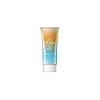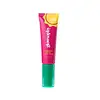What's inside
What's inside
 Key Ingredients
Key Ingredients

 Benefits
Benefits

 Concerns
Concerns

 Ingredients Side-by-side
Ingredients Side-by-side

Water
Skin ConditioningAlcohol Denat.
AntimicrobialEthylhexyl Methoxycinnamate
UV AbsorberButylene Glycol
HumectantDiphenylsiloxy Phenyl Trimethicone
Skin ConditioningDiethylamino Hydroxybenzoyl Hexyl Benzoate
UV FilterTitanium Dioxide
Cosmetic ColorantSodium Hyaluronate
HumectantSodium Ascorbyl Phosphate
AntioxidantOenothera Biennis Flower Extract
AstringentBarm Extract
Skin ConditioningBis-PEG-18 Methyl Ether Dimethyl Silane
EmollientMethyl Methacrylate Crosspolymer
Bis-Ethylhexyloxyphenol Methoxyphenyl Triazine
Skin ConditioningAcrylates Copolymer
Polysorbate 60
EmulsifyingAcrylates/C10-30 Alkyl Acrylate Crosspolymer
Emulsion StabilisingMelaleuca Alternifolia Leaf Oil
AntioxidantAmmonium Acryloyldimethyltaurate/Vp Copolymer
Silica
AbrasivePEG-12 Dimethicone
Skin ConditioningPolystyrene
Polyvinyl Alcohol
Disodium EDTA
Xanthan Gum
EmulsifyingAlumina
AbrasiveBHT
AntioxidantPolyglyceryl-2 Triisostearate
EmulsifyingSynthetic Fluorphlogopite
Tin Oxide
AbrasiveCI 45380
Cosmetic ColorantBlue 1 Lake
Cosmetic ColorantParfum
MaskingWater, Alcohol Denat., Ethylhexyl Methoxycinnamate, Butylene Glycol, Diphenylsiloxy Phenyl Trimethicone, Diethylamino Hydroxybenzoyl Hexyl Benzoate, Titanium Dioxide, Sodium Hyaluronate, Sodium Ascorbyl Phosphate, Oenothera Biennis Flower Extract, Barm Extract, Bis-PEG-18 Methyl Ether Dimethyl Silane, Methyl Methacrylate Crosspolymer, Bis-Ethylhexyloxyphenol Methoxyphenyl Triazine, Acrylates Copolymer, Polysorbate 60, Acrylates/C10-30 Alkyl Acrylate Crosspolymer, Melaleuca Alternifolia Leaf Oil, Ammonium Acryloyldimethyltaurate/Vp Copolymer, Silica, PEG-12 Dimethicone, Polystyrene, Polyvinyl Alcohol, Disodium EDTA, Xanthan Gum, Alumina, BHT, Polyglyceryl-2 Triisostearate, Synthetic Fluorphlogopite, Tin Oxide, CI 45380, Blue 1 Lake, Parfum
Water
Skin ConditioningCetearyl Alcohol
EmollientCera Alba
EmollientButyl Methoxydibenzoylmethane
UV AbsorberTitanium Dioxide
Cosmetic ColorantCetyl Ethylhexanoate
EmollientGlycerin
HumectantButyrospermum Parkii Butter
Skin ConditioningCyclopentasiloxane
EmollientCI 77891
Cosmetic ColorantCyclohexasiloxane
EmollientPEG-20 Stearate
EmulsifyingPotassium Cetyl Phosphate
EmulsifyingNiacinamide
SmoothingPhenoxyethanol
PreservativeCarbomer
Emulsion StabilisingMethylparaben
PreservativeAllantoin
Skin ConditioningCI 77492
Cosmetic ColorantTriethanolamine
BufferingAlumina
AbrasiveCI 77491
Cosmetic ColorantButylene Glycol
HumectantSorbitan Olivate
EmulsifyingCetearyl Olivate
Aluminum Hydroxide
EmollientTriethoxycaprylylsilane
Alpha-Arbutin
AntioxidantSaururus Chinensis Leaf/Root Extract
AntimicrobialMorus Alba Fruit Extract
Antioxidant1,2-Hexanediol
Skin ConditioningArctostaphylos Uva-Ursi Leaf Extract
Skin ConditioningHydroxyacetophenone
AntioxidantFructose
HumectantSodium Hyaluronate
HumectantCeramide As
Skin Conditioning3-O-Ethyl Ascorbic Acid
Skin ConditioningCeramide EOP
Skin ConditioningPhosphatidylcholine
EmulsifyingTocopherol
AntioxidantCeramide NP
Skin ConditioningPolyglyceryl-10 Oleate
Skin ConditioningAloe Barbadensis Leaf Extract
EmollientPortulaca Oleracea Flower/Leaf/Stem Extract
AntioxidantSodium Stearoyl Glutamate
CleansingAnthemis Nobilis Flower Extract
MaskingPelargonium Graveolens Flower/Leaf/Stem Extract
MaskingGlyceryl Caprylate
EmollientWater, Cetearyl Alcohol, Cera Alba, Butyl Methoxydibenzoylmethane, Titanium Dioxide, Cetyl Ethylhexanoate, Glycerin, Butyrospermum Parkii Butter, Cyclopentasiloxane, CI 77891, Cyclohexasiloxane, PEG-20 Stearate, Potassium Cetyl Phosphate, Niacinamide, Phenoxyethanol, Carbomer, Methylparaben, Allantoin, CI 77492, Triethanolamine, Alumina, CI 77491, Butylene Glycol, Sorbitan Olivate, Cetearyl Olivate, Aluminum Hydroxide, Triethoxycaprylylsilane, Alpha-Arbutin, Saururus Chinensis Leaf/Root Extract, Morus Alba Fruit Extract, 1,2-Hexanediol, Arctostaphylos Uva-Ursi Leaf Extract, Hydroxyacetophenone, Fructose, Sodium Hyaluronate, Ceramide As, 3-O-Ethyl Ascorbic Acid, Ceramide EOP, Phosphatidylcholine, Tocopherol, Ceramide NP, Polyglyceryl-10 Oleate, Aloe Barbadensis Leaf Extract, Portulaca Oleracea Flower/Leaf/Stem Extract, Sodium Stearoyl Glutamate, Anthemis Nobilis Flower Extract, Pelargonium Graveolens Flower/Leaf/Stem Extract, Glyceryl Caprylate
 Reviews
Reviews

Ingredients Explained
These ingredients are found in both products.
Ingredients higher up in an ingredient list are typically present in a larger amount.
Alumina is another name for the compound aluminum oxide. It is a white powder used as a thickener, absorbent, and abrasive.
As an absorbent, alumina can give a mattifying effect. It is used in mineral sunscreens to help coat nano-sized filters, such as titanium dioxide. By increasing the size of the UV filters, these ingredients stay on the skin for a longer time. By coating small sized ingredients, alumina helps thicken a product.
Alumina may be used as an abrasive, or exfoliant.
Alumina is naturally occurring in the mineral corundum. Certain varieties of corundum create rubies and sapphires. Corundum is also the crystalline form of alumina.
Learn more about AluminaButylene Glycol (or BG) is used within cosmetic products for a few different reasons:
Overall, Butylene Glycol is a safe and well-rounded ingredient that works well with other ingredients.
Though this ingredient works well with most skin types, some people with sensitive skin may experience a reaction such as allergic rashes, closed comedones, or itchiness.
Learn more about Butylene GlycolSodium Hyaluronate is hyaluronic acid's salt form. It is commonly derived from the sodium salt of hyaluronic acid.
Like hyaluronic acid, it is great at holding water and acts as a humectant. This makes it a great skin hydrating ingredient.
Sodium Hyaluronate is naturally occurring in our bodies and is mostly found in eye fluid and joints.
These are some other common types of Hyaluronic Acid:
Learn more about Sodium HyaluronateTitanium dioxide is a mineral UV filter widely used in sunscreens and cosmetics.
It is one of only two UV filters officially classified as “mineral” by regulatory agencies, the other being zinc oxide.
Titanium dioxide provides broad-spectrum protection mostly in the UVB and UVAII range, with some protection in the UVAI range.
While its UVA protection isn’t as strong as zinc oxide’s, the difference is minor.
A common myth is that mineral UV filters reflect UV light. However, modern research shows titanium dioxide absorbs UV radiation like chemical filters (~95% absorption & 5% reflection).
Thanks to its non-irritating nature, titanium dioxide is suitable for sensitive, acne-prone, or redness-prone skin. It is unlikely to cause "eye sting" like other sunscreen ingredients.
A major drawback of this ingredient is its white cast and thick texture. This is why mineral sunscreens often leave a white cast and are less cosmetically elegant than chemical/hybrid sunscreens.
To improve white cast and spreadability, micronized or nano-sized titanium dioxide is often used.
There are ongoing concerns surrounding nano-titanium oxide's impact on marine ecosystems.
There is no conclusive evidence that any form of titanium oxide (or any other sunscreen ingredients) will cause harm to marine ecosystems or coral reefs. The science is still developing but many consumers are keeping a close eye on this issue.
Please note, many destinations have reef-safety sunscreen rules. For instance, the U.S. Virgin Islands advises all visitors to use non-nano mineral sunscreens.
Nano mineral sunscreens once raised safety concerns about absorption into skin.
Extensive research has shown that they do not penetrate healthy or damaged skin; they remain safely on the surface and the top layer of dead skin (stratum corneum).
You'll likely find titanium dioxide bundled with alumina, silica, or dimethicone. These ingredients help make titanium dioxide highly photostable; this prevents it from interacting with other formula components under UV light.
Learn more about Titanium DioxideWater. It's the most common cosmetic ingredient of all. You'll usually see it at the top of ingredient lists, meaning that it makes up the largest part of the product.
So why is it so popular? Water most often acts as a solvent - this means that it helps dissolve other ingredients into the formulation.
You'll also recognize water as that liquid we all need to stay alive. If you see this, drink a glass of water. Stay hydrated!
Learn more about Water